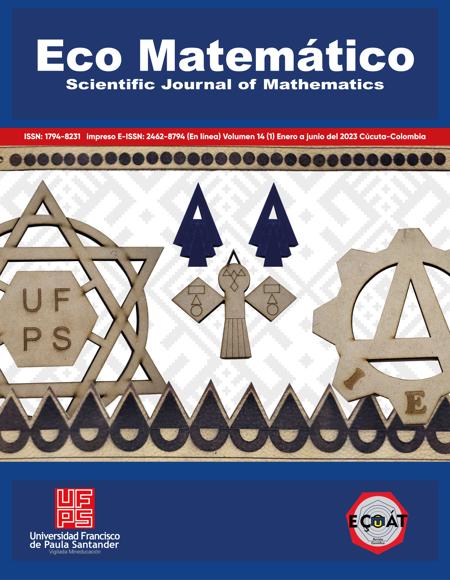Axiomática del conjunto de las frecuencias musicales en una octava
Axiomatic of the set of musical frequencies in an octave
Contenido principal del artículo
La mayor parte de los trabajos que relacionan las matemáticas con las frecuencias musicales se basan en el fenómeno físico armónico, los sistemas de afinación y la teoría de escalas bien formadas. En este artículo se estudia el vínculo entre las notas (frecuencias) musicales en el ámbito de una octava y la teoría axiomática de conjuntos, el álgebra de grupos y el análisis real. Se llega a la conclusión de que el conjunto de las notas (frecuencias) musicales en una octava está bien ordenado y cumple el axioma del supremo. Además, el conjunto de los intervalos (frecuencias) musicales en una octava, con la operación interna suma, tiene estructura de grupo conmutativo. También se muestran otros resultados de la teoría algebraica de grupos.
Descargas
Datos de publicación
Perfil evaluadores/as N/D
Declaraciones de autoría
Indexado en
- Sociedad académica
- Universidad Francisco de Paula Santander
- Editorial
- Universidad Francisco de Paula Santander
Detalles del artículo
Abbott, S. (2015). Understanding Analysis. New York: Springer. DOI: https://doi.org/10.1007/978-1-4939-2712-8
https://ndl.ethernet.edu.et/bitstream/123456789/88631/1/2015_Book_UnderstandingAnalysis.pdf
Artin, M. (2011). Algebra. Boston: Pearson.
https://indaga.ual.es/discovery/fulldisplay/alma991001482049704991/34CBUA_UAL:VU1
Assayag, G., Feichtinger, H. G. y Rodrigues, J. F., eds. (2020). Mathematics and Music:
A Diderot Mathematical Forum. Cham, Switzerland: Springer.
https://link.springer.com/book/10.1007/978-3-662-04927-3
Bartle, R. G. y Sherbet, D. R. (2011). Introduction to Real Analysis. Hoboken, New Jersey:
John Willey & Sons.
https://sowndarmath.files.wordpress.co./2017/10/real-analysis-by-bartle.pdf
Benson, D. J. (2006). Music: A Mathematical Offering. Cambridge: Univ. Press.
https://doi.org/10.1017/CBO9780511811722 DOI: https://doi.org/10.1017/CBO9780511811722
https://logosfoundation.org/kursus/music_math.pdf
Bukovský, L. (2011). The Structure of the Real Line. Basel: Birkhäuser. DOI: https://doi.org/10.1007/978-3-0348-0006-8
https://doi.org/10.1007/978-3-0348-006-8
https://link.springer.com/book/10.1007/978-3-0348-0006--8
Castrillón, M. y Domínguez, M. (2013). Un encuentro entre las matemáticas y la teoría
de escalas musicales: Escalas bien formadas. La Gaceta de la RSME, 16, 87-106.
https://gacetarsme.es/abris.php?id=1130
Damschroder, D. y Russell, D. (2013). Music Theory from Zarlino to Schenker: A
Bibliography and Guide. New York: Pendragon Press, Stuyvesant.
https://search.worldcat.org/es/formats-editions/21195293
Fauvel, J. Raymond, F. y Wilson, R. (2003). Music and Mathematics: From Pythagoras DOI: https://doi.org/10.1093/oso/9780198511878.001.0001
to Fractals. Oxford: Oxford University Press.
https://global.oup.com/academic/product/music-and-mathematics-9780199298938
Foreman, M. y Kanamori, A. (eds., 2010). Handbook of Set Theory. New York: Springer. DOI: https://doi.org/10.1007/978-1-4020-5764-9
https://link.springer.com/book/10.1007/978-1-4020-5764-9
Gallian, J. A. (2019). Contemporery Abstract Algebra. Boston: Cengage Learning.
Goldáraz Gainza, J. J. (1992). Afinación y temperamento en la música occidental. Madrid:
Alianza Música.
https://riunet.upv.es/bitstream/handle/10251/18491/Memoria.pdf?sequence=1
Harkleroad, L. (2006). The Math behind the Music. Cambridge: Cambridge University
Press.
https://archive.org/details/mathbehindmusic0000hark/mathbehindmusic0000hak
Kunen, K. (2011). Set Theory: An Introduction to Independence Proofs. Boca Raton:
Chapman and Hall.
Maor, E. (2018). Music by the Numbers: From Pythagoras to Schöenberg. Princeton, DOI: https://doi.org/10.23943/9781400889891
New Jersey: Princeton University Press.
https://ieeexplore.ieee.org/document/9453279
Mazzola, S. (2018). The Topos of Music I: Geometric Logic of Concepts, Theory and DOI: https://doi.org/10.1007/978-3-319-64364-9
Performance. Cham, Switzerland: Springer.
https://search.app.goo.gl/YG6G5yY
Mazzola, S. (2018). The Topos of Music II: Performance. Theory, Software and Case DOI: https://doi.org/10.1007/978-3-319-64444-8
Studies. Cham, Switzerland: Springer.
https://link.springer.com/book/10.1007/978-3-319-64444-8
Tymoczko, D. (2011). A Geometry of Music: Harmony and Counterpoint in the
Extended Common Practice. Oxford: Oxford University Press.
Wright, D. (2015). The Mathematics of Music: Theory and Compositions. Boca Raton,
Florida: CRC Press.








